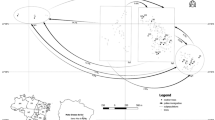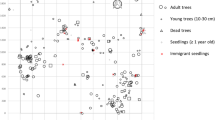Abstract
The introgression of genes from exotic species or populations into gene pools of native species is a widespread concern in agricultural systems. This is also an issue of increasing importance in forest systems as there has been a dramatic expansion of tree plantations, which have now reached 180 million ha globally. This has recently occurred in Australia with eucalypts. To help assess the risk of genetic pollution, we assess the pattern of realised pollen dispersal from exotic Eucalyptus nitens plantations into native E. ovata forest in Tasmania. We assessed the frequency of F1 hybrids in open-pollinated seed collected from native E. ovata trees located at varying distance from three exotic E. nitens plantations in Tasmania. Over 119,000 seedlings were screened for morphological markers diagnostic of each species and the F1 hybrid. F1 hybridisation averaged 7.2% within 100 m of the exotic E. nitens, with one native tree reaching 56%, but diminished to 0.7% by 200–300 m and continued at this low level to the limits of the sampling at 1.6 km. The decay in the percentage of interspecific F1 hybridisation with distance followed a power function with a negative exponent (%F1 = 91.435distance−0.789; R2=0.84). Eucalyptus nitens is exclusively pollinated by small insects (smaller than honeybees), which the study shows can disperse pollen over 1.6 km. However, the restriction of most exotic F1 hybridisation to within 200 m of exotic plantations presents clear opportunities to manage the genetic impacts of plantations on native forests.
Similar content being viewed by others
References
WT Adams (1992) ArticleTitleGene dispersal within forest tree populations New For 6 217–240
RC Barbour BM Potts RE Vaillancourt WN Tibbits RJE Wiltshire (2002) ArticleTitleGene flow between introduced and native Eucalyptus species New For 23 177–191
RC Barbour BM Potts RE Vaillancourt (2003) ArticleTitleGene flow between introduced and native Eucalyptus species; exotic hybrids are establishing in the wild Aust. J. Bot 51 429–439
Carle J (2001) Forest plantations. In: Global Forest Resources Assessment. Main Report, pp. 23–38. Food and Agriculture Organisation of the United Nations
RE Daniels J Sheil (1999) Genetic pollution: concepts, concerns and transgenic crops PW Lutman (Eds) Gene Flow and Agriculture: Relevance to Transgenic Crops British Crop Protection Council Farnham, UK 65–72
CW Dick G Etchelecu F Austerlitz (2003) ArticleTitlePollen dispersal of tropical trees (Dinizia excelsa: Fabaceae) by native insects and African honeybees in pristine and fragmented Amazonian rainforest Mol. Ecol 12 753–764 Occurrence Handle12675830
SP DiFazio S Leonardi S Cheng SH Strauss (1999) Assessing the potential risks of transgene escape from fiber plantations PW Lutman (Eds) Gene Flow and Agriculture: Relevance for Transgenic Crops British Crop Protection Council Farnham, UK 171–176
NC Ellstrand (1992) ArticleTitleGene flow among seed plant populations New For 6 241–256
AR Griffin IP Burgess L Wolf (1988) ArticleTitlePatterns of natural and manipulated hybridisation in the genus Eucalyptus L’Herit. - a review Aust. J. Bot 36 41–66
JL Hamrick JD Nason (2000) Gene flow in forest trees A Young D Boshier T Boyle (Eds) Forest Conservation Genetics: Principles and Practice CABI Publishing Wallingford UK 81–90
AB Hingston PB McQuillan BM Potts (2004) ArticleTitlePollinators in seed orchards of Eucalyptus nitens Aust. J. Bot 52 209–222
NA Linacre PK Ades (2004) ArticleTitleEstimating isolation distances for genetically modified trees in plantation forestry Ecol. Model 179 247–257
GE McKinnon GJ Jordan RE Vaillancourt DA Steane BM Potts (2004) ArticleTitleGlacial refugia and reticulate evolution: the case of the Tasmanian eucalypts Philos. Trans. R. Soc. Lond. B Biol. Sci 359 275–284 Occurrence Handle15101583
WF Morris PM Kareiva PL Raymer (1994) ArticleTitleDo barren zones and pollen traps reduce gene escape from transgenic crops Ecol. Appl 4 157–165
G Muir CC Fleming C Schlotterer (2000) ArticleTitleTaxonomy – species status of hybridizing oaks Nature 405 1016–1016 Occurrence Handle1:CAS:528:DC%2BD3cXkvFKlsrs%3D Occurrence Handle10890434
E Muller H Guilloy-Froget N Barsoum L Brocheton (2002) ArticleTitlePopulus nigra L. in the Garonne Valley: legacy of the past and present constraints C. R. Biol 325 1129–1141 Occurrence Handle12506726
BM Potts RJE Wiltshire (1997) Eucalypt genetics and genecology J Wiliams J Woinarski (Eds) Eucalypt Ecology: Individuals to Ecosystems Cambridge University Press Cambridge 56–91
BM Potts RC Barbour AB Hingston RE Vaillancourt (2003) ArticleTitleTurner review: the risks of genetic pollution of native eucalypt gene pools Aust. J. Bot 51 1–25
JM Rhymer D Simberloff (1996) ArticleTitleExtinction by hybridisation and introgression Ann. Rev. Ecol. Syst 27 83–109
SG Southerton P Birt HA Ford (2004) ArticleTitleReview of gene movement by bats and birds and its potential significance for eucalypt plantation forestry Aust. For 67 44–53
SY Strauss (2001) ArticleTitleBenefits and risks of biotic exchange between Eucalyptus plantations and native Australian forests Aust. Ecol 26 447–457
J Turnbull (1999) ArticleTitleEucalypt plantations New For 17 37–52
M Vila E Weber CMD Antonio (2000) ArticleTitleConservation implications of invasion by plant hybridization Biol. Invasions 2 207–217
Wardell-Johnson G, Williams JE, Hill K, Cumming R (1996) Evolutionary biogeography and contemporary distribution of Eucalyptus. In: Eucalypt Ecology: Individuals to Ecosystems (eds. Williams J, Woinarski J), pp. 92–128. Cambridge University Press, Cambridge
Wood MS, Stephens NC, Allison BK, Howell CI (2001) Plantations of Australia – A Report from the National Plantation Inventory and the National Farm Forest Inventory. Bureau of Rural Sciences, Canberra
WRI (2000) World Resources 2000–2001 – People and ecosystems: The Fraying Web of Life World Resources Institute Washington
Author information
Authors and Affiliations
Corresponding author
Rights and permissions
About this article
Cite this article
Barbour, R.C., Potts, B.M. & Vaillancourt, R.E. Pollen dispersal from exotic eucalypt plantations. Conserv Genet 6, 253–257 (2005). https://doi.org/10.1007/s10592-004-7849-z
Issue Date:
DOI: https://doi.org/10.1007/s10592-004-7849-z




